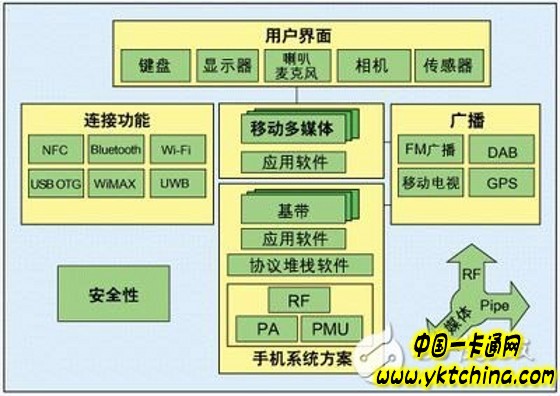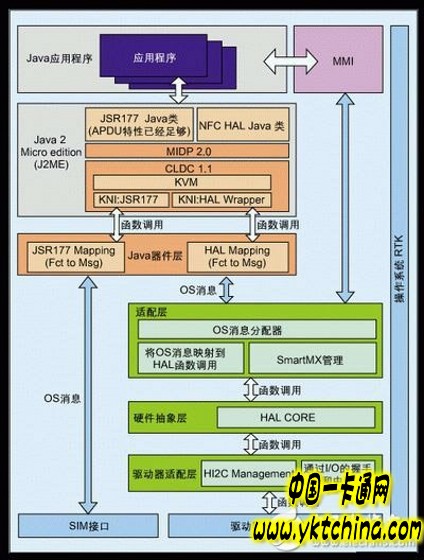Near-field wireless communication (NFC) technology fills the gap in current wireless connection technology. NFC function will be one of the future mobile phone functions, providing an effective implementation solution for mobile payment and information download services. This article describes the software and hardware implementation of Philips Semiconductors' combination of its high-end Nexperia cellular handset solution with NFC technology and analyzes its application prospects.
Just five years ago, mobile phone manufacturers were only able to launch 5 to 10 new products each year. Today, some manufacturers are able to launch 40 new products each year, each targeting a specific market. In addition, compared to the past, mobile phones are more feature-rich, and prices have dropped. Cellular system solutions have been at the forefront of this trend, and semiconductor solution providers continue to help manufacturers launch new products with new features to keep pace with the market and maintain and expand their customer base.
To lead the development of system solutions, Philips is committed to developing compatible multimedia building blocks and connectivity intellectual property (IP) that help developers easily integrate the new features they need into Nexperia system solutions. By extending such system solutions, manufacturers are able to easily diversify their products and quickly apply new technologies to mobile phones that meet the changing needs of operators. The latest NFC technology can support many new applications. With Philips' complete software/hardware IP combination and integration technology, design engineers can make design changes based on Nexperia cellular system solutions to develop more sophisticated multimedia phones. With Philips' NFC system solution, the secure connection method has become an optional feature for many mobile phones, such as MMS, MP3, JAVA, voice recognition, MPEG video and FM radio.
Philips' first NFC-enabled Nexperia cellular system solution is targeted at high-end handsets and is integrated into the Nexperia Sy.Sol 6100. Key features of the design include: a fully validated solution including a powerful baseband (embedded ARM9 processor core); the industry's first EDGE system solution, mass production in the fourth quarter of 2004; and full multimedia capabilities.

Figure 1: Nexperia mobile phone system solution
NFC technology
NFC was jointly developed by Philips and Sony to fill the gap in the current connection technology. NFC is a wireless connectivity technology that is compatible with existing contactless smart card technologies and is now the official standard supported by more and more major vendors. NFC is also a close-range connection protocol that provides easy, secure, fast and automatic communication between devices. Compared with the connection method in the wireless world, NFC is a close-range private communication method.
As a virtual connector, NFC can be used to quickly implement various wireless communications on a device. By bringing two NFC devices closer together, you can wirelessly configure and initialize other wireless protocols, such as Bluetooth and 802.11, so that the device can communicate over long distances or transfer data at high speed. The frequency of the NFC itself is 13.56 MHz and the working distance is a few centimeters. NFC technology complies with ISO 18092, ISO 21481, ECMA (340, 352 and 356) and ETSI TS 102 190 standards. NFC is also compatible with non-contact smart card infrastructure that is widely used in the ISO 14443 standard, such as Philips' MIFARE technology and Sony's FeliCa system.
With seamless wireless networking and identification provided by NFC, we can directly access content and services simply by contacting NFC smart devices or bringing NFC smart devices closer together. NFC also offers many opportunities for mobile phones to interact with the outside world. For today's "connected consumers," mobile phones are essential. The mobile phone is a multi-purpose communication, entertainment, camera and navigation tool that quickly became the only portable device we needed. By integrating NFC into mobile phone system solutions, the availability, versatility and added value of mobile phones are greatly enhanced, and secure payment, peer-to-peer connections, and access to passive smart devices will become a reality.
NFC-enabled Nexperia system solution
NFC applications have unlimited potential, but when adding NFC functionality to new technologies, they often face technical bottlenecks in detail. Therefore, as a system solution provider, Philips decided to promote the adoption of NFC in an easy way, by integrating proven technology into the Nexperia cellular system solution (see Figure 1). This is the first step in rapidly popularizing the technology, not only economically feasible but also simple for manufacturers and consumers.
Philips' first NFC-enabled cellular system solution has been applied to the Nexperia Sy.Sol 6100 platform. The solution was demonstrated in early 2004 and prototypes are available and will be commissioned with a leading handset manufacturer and network operator in early 2005.
Hardware implementation
The hardware NFC function is implemented by two chips, namely the built-in firmware PN531 NFC controller and Philips SmartMX (SMX), which is a smart card dual interface security controller. The SmartMX is fully supplied and controlled by the PN531 via the twisted pair S2C (Signal Input/Output Communication Interface) interface. The PN531 is in turn controlled by the baseband processor via the I2C bus and two general purpose I/Os (GPIOs) for handshaking. The antenna circuit is divided into two, namely EMC filter + RX path and antenna tuning, so you can freely choose where to set the non-contact antenna (currently set in a dedicated battery pack). Another GPIO is used to control the LDO (Low Dropout Linear Regulator) that provides NFC power.

Figure 2: System software implementation block diagram
In smart card emulation mode, the RF transceiver is completely controlled by SmartMX, and the PN531 does not sense data exchange, thus ensuring the safety factor required for traffic or paid applications. When the transfer with the external card reader is completed, the SmartMX signals and the PN531 can read the result (success or failure) in the SmartMX.
Sold Double Side Tape, Joint Wrap Tape, Inner Tape , Bitumen Tape in China.
Cold applied coating tape Composition:It is tape-shaped anticorrosion material made of Polyethylene film heat laminated with adhesive layer of butyl glue.
Usage: It is extensively used in the pipework of oil and natural gas transportation, petrochemical industry, electric power, metallurgy, urban natural gas network of pipes, the outside anticorrosion project of the metal pipes involved as well as the outside anticorrosion project of the underground and overhead metallic conduit of the works of petrochemical industry, natural gas and coal transportation
Thickness: 0.30 - 2.0 mm
Color : Black white
Other name: inner tape, cold wrap tape
Thickness :15 mil to 35 mil
Width: 50, 100, 150, 200, 300 mm
Length : 10, 20, 25, 30, 50,120 meter
Certificate :ISO 9001, ISO 14001,OHSMS 18001,SGS
Standard : ASTM D 1000, AWWA C 214
Temperature: 10 to 60 degree c



China professional manufacturer of Bitumen Tape, Inner Tape, Joint Wrap Tape, Double Side Tape. Welcome Purchasers from Worldwide to Visit Our Site.
Double Side Tape, Joint Wrap Tape, Inner Tape, Bitumen Tape
Jining Xunda Pipe Coating Materials Co.,Ltd , https://www.pipe-wrap.com